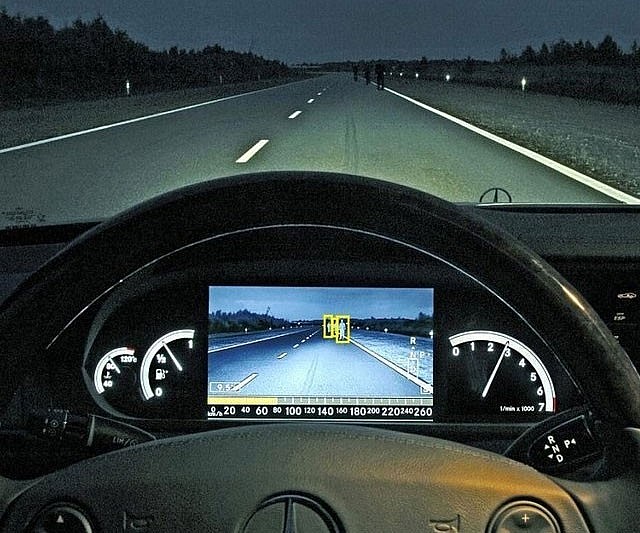During night time, there are some chances to not identify some large animals, cyclist, pedestrians, and some obstacles in the roadway. Night Vision System (NVS) is used to increase the driver's visibility in darkness or poor weather condition (Fog or smog) beyond the reach of the vehicle's headlights. An enhanced Night Vision System gives drivers additional time to react. Night Vision System has an infrared camera system that can detect animals and people over 100 yards ahead of the vehicle beyond typical headlight range.
In order to understand night vision, it is important to understand the basics of light and the electromagnetic spectrum. Human's eyes can see only the rays falling under the visible region of the electromagnetic spectrum and can not see both the infra-red as well as the ultraviolet region of the electromagnetic spectrum.
Night Vision System makes it possible for humans to see the rays falling in the infra-red region of the electromagnetic spectrum. The night vision systems used in automobiles captures the infra-red image of distant obstacles on the road since every object emits infra-red rays (heat rays) even during the night. This image is viewed on a screen and thus the driver can take appropriate action to avoid the collision.
Active Night Vision System or Near-infrared System
This system uses an infrared light source built into the vehicle to capture the road ahead. Since the infrared light is not visible to the human eyes, these types of light sources do not cause the vision of oncoming drivers like high beam lights. Active Night Vision System can help drivers to see 150 to 300 meters by adopting imaging sensor. Moreover in total darkness without any street light, the infrared night vision function can clearly show the natural images of the front road. This can greatly improve the driving safety at night.The infrared illuminator used in the night vision system is sometimes the part of the headlamp cluster which helps to light up the road in the infrared spectrum. The resolution of the image produced in the active night vision system is higher than the passive system since it uses special cameras to stream the extra visual data. Some of the systems use pulsed infrared lights and some systems use constant light source. The system may not work good in adverse weather conditions like heavy snow and hail. Because they may partially block the infrared light source.
This system is called Near-Infrared system because it uses near-infrared light waves for the detection of objects. It detects the portion of the infrared band nearest to visible light. It requires special bulbs mounted next to the headlights to project invisible NIR light onto the surrounding area but they don't spoil the vision of other drivers since infrared light is insensitive to the human eyes. The NIR system illuminates infrared light in the surroundings in the wavelength of 800 to 900 nm. The camera captures the reflected NIR light from the surroundings and intensifies it to get an enhanced image.
Passive Night Vision System or Far Infrared System
This type of system uses Far infrared (FIR) light waves that detect energy farther up the infrared band. This type of technology also called thermal imaging because it detects the energy emitted by objects as heat.This system uses a thermographic camera. The thermal imaging process happens by a lens focuses the infrared light. Then the focused light is scanned and create temperature pattern called thermogram. It only takes about one-thirtieth of a second (30 times in a second) for the detector array to obtain the temperature information to make the thermogram. The created pattern is translated into electric impulses and that will be sent to a circuit board to convert the information into data for the display. The image appears as various colors based on the intensity of the infrared emission. The combination of all the impulses from all of the elements creates the image in the display.
Some other automotive safety-related articles:
Automotive Safety systems- Introduction
Anti-lock Braking System (ABS) - Simple Explanation
Electronic Stability Control (ESC) - Simple Explanation
Traction Control System (TCS) - Simple Explanation
Automotive Safety systems- Introduction
Anti-lock Braking System (ABS) - Simple Explanation
Electronic Stability Control (ESC) - Simple Explanation
Traction Control System (TCS) - Simple Explanation


Comments
Post a Comment